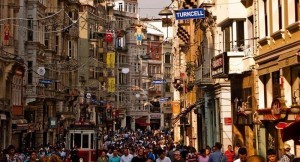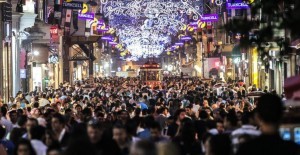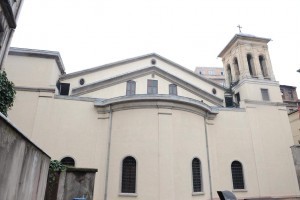Home › Forums › Walking Tours › Beyoğlu, Taksim Historical Walk
This topic contains 0 replies, has 1 voice, and was last updated by PremiumTravel 6 years, 6 months ago.
- AuthorPosts
- 14/06/2017 at 7:42 pm #8602
Tour Name: Beyoğlu, Taksim Historical Walk
Tour Type: Private
Price: Please Ask
Availability: Everyday
Walking Tour in Istanbul – Beyoğlu
Start with the Republic Monument in Taksim Square. The monument was erected in 1928 in commemoration of the foundation of the Turkish Republic. On the side that faces İstiklal Caddesi, Mustafa Kemal Atatürk, the founder of the Turkish Republic, as well as İsmet Inönü, president and later prime minister of the Republic, and Fevzi Çakmak, the first chief of staff for the Republic, stride forward. On the side facing Cumhuriyet Caddesi, Atatürk the soldier is depicted in battle. The monument is a popular meeting point, though my friends and I prefer the tram stop where you can pick up the Nostalgic tram or the area around the Burger King nearby. Walking away from the tram, you’ll notice a long building with a fountain and two stone houses. This building was once the central water distribution center for Istanbul, starting in the early 18th century. These days this smooth, stone Ottoman front sports a light show at night and frequent art exhibitions organized by the Beyoğlu Municipality.
Further on to your right is the yellow-stoned French Cultural Centre, a building from the 18th century designed as a hospital which later served as an orphanage. Take a moment to study the delicate Corinthian columns before taking a step into the courtyard (Note that you’ll have to go through a metal detector and an x-ray machine to do this – no biggie, for any of us who live here.) The white graveled courtyard is truly straight out of France, and their cafe is a lovely spot for coffee or drinks, though they don’t stay open past 9 pm.

Going Cross Istiklal Street
Exiting the courtyard, cross İstiklal to make a left on Meşelik Sokak, where about midway through you’ll come across Aghia Triada, a grand church built in 1880. Go into the courtyard and greet the cats before ascending the pathway and the steps to light a candle. The church is closed every day but Sunday morning. If you’re lucky on a Sunday morning, you may get to tiptoe in to see the gorgeous but eclectic chandeliers, Western-styled icons, and massive icon screen inside. Turn away from Aghia Triada back to İstiklal. Just before the monstrous Demirören Mall, which was opened in 2011, copying, or so it claimed, a previous building in its spot, is the Hüseyin Ağa Mosque. Built in 1596 and restored in 1934 after a devastating fire, it’s currently getting its second facelift. Though its location seems strange to even now, when it was built it was the first mosque outside of the walls of the old city in the Golden Horn.

One of the Oldest Cinemas in Istanbul
Walk further and to your left will be Atlas Pasajı, home to one of the last old cinemas of Istanbul. İstiklal used to be covered with movie theaters, with giant movie posters and larger than life cut outs looming above marquees, but these days everything is much simpler. The movie theater in Atlas Pasajı is far from being the grandest of the lot, but it’s a reminder of the areas cinema heritage. Built in 1870 as a passageway, it was transformed into a cinema in 1948. Today it retains a slew of shops and is one of the theaters which screens the film for the annual Istanbul Film Festival. Unlike Yeşilçam Sokak, which retains no trace of the famous offices of the Turkish movie industry, Atlas has somehow managed to endure, but with all the other theaters shut down, my friends and I think its only a matter of time before this special place goes too.
You can take a look at our the Best Istanbul Tour.
United States Information Service
Farther down to your right you’ll see the Greek flag flying parallel with the EU flag. Don’t be fooled into thinking that this grand 19th-century building, know as the Şişmanoğlu Megaron after the former owner, Konstantinos Sismanoglou is the actual consulate for Greece in Istanbul. The real consulate is actually tucked in a street off of İstiklal (just like the real consulate for France), and this charming building, which has taken its turns through history as a private residence (pre-1939), a woodworking shop and a free English language library run by the United States Information Service (USIS) (until 1968), and is now by a Greek cultural centre (2009-today). There’s usually a good exhibition going on, which is usually pretty art-heavy, but the building from the inside is a real treat and a great break from the noise of İstiklal, so going through the front doors is definitely worth it.

Patriarch of the Greek Orthodox Church
As if there weren’t enough Greek sites on İstiklal, going off the main street to Turnacıbaşı Caddesi will take you in front of Zografyon High School, one of the remaining Greek minority high schools. Built in 1893, through community donations, over the years many famous members of the Greek diaspora and local community have studied there, including the current Patriarch of the Greek Orthodox Church, Patriarch Bartholomew I. The school’s mascot, the sphinx which represents the quest for knowledge, is a fresco on the left and right of the building. The pediment of the school includes a fresco of the Madonna holding Christ.
See also 2-days Istanbul Tour without accommodation.

Galatasaray High School
The wall running across the street from Zografyon belongs to the very famous francophone Galatasaray High School, founded at the end of the 15th century by Sultan Beyazıt II. The buildings on campus were built in 1908 following the reorganization of the school as a modern French-styled lycée by Sultan Abdül Aziz in 1868. Follow the wall back to İstiklal to gaze in through the large Ottoman gates. Luminaries such as painter Namık İsmail, musician Barış Manço, journalist Abdi İpekçi, and Ottoman grand vizier Ali Rıza Paşa are among the ranks of its alumni.
Across the street from Galatasaray High School are Çiçek Pasajı (Flower Passage) and Balık Pasajı (Fish Passage). Çiçek Pasajı was built in 1876 as an area for shops and apartments. Once home to many locally frequented meyhanes (the Turkish word for tavernas, these days it’s home to a bunch of overpriced restaurants. Take a peep in and enjoy the view, but to get the real meyhane experience, it’s best to go with a group to Balık Pasajı next door where, yes, you guessed it, a fish market used to take up all of the streets. These days you can still find great fish on that street, as well as some locally sourced poultry (if you’re looking for a Turkey for American Thanksgiving, this is one place to order them from), but most of us who hang around here are in for drinking in Nevizade, a few streets lined with bars which all look the same, or a meyhane night at a place like Cumhuriyet Meyhanesi, once a favourite of Atatürk himself. If this is not the time to eat dinner with a large group, however, step away from the restaurants and just enjoy the smells and presentation of the produce, game, and seafood.
You can join our Bosphorus Cruise Tours anytime!
The Madonna of the Doors
After that our walking tour continues with the past Balık Pazarı, hang a left at the T-junction at the end (Kamer Hatun Caddesi). Take another immediate left onto Hamalbaşı Caddesi, and the third one on Meşrutiyet Caddesi. Resist the temptation of stepping into the Japanese shop which will come up on your left and turn into the passageway immediately afterward instead, which will open up into Hazzopulo Pasajı, a stone-dappled courtyard with loads of tea-drinking young people and curious shops away from the din of İstiklal. Stop here if you like for tea. In the center of the courtyard to your right are two large iron gates. If open, pass through, where you’ll see the tiny Panagia Edition – The Madonna of the Doors. This Greek Orthodox church was built in 1804 and was renovated in 2010. Enjoy the courtyard and the narthex of the church, which has some unusual frescoes, but see also if you can find the other two entrances to the church. There are three in total, and usually at least two are visible and open, with the third usually well-hidden. We continue to our Istanbul walking tour with the exiting from the entrance you came through and turn back out onto Meşrutiyet Caddesi. Continue, admiring the walls of the British Consulate on your right. The newly constructed “old” buildings adjacent to it belong to the Rixos Hotel, but the peaceful courtyard contains the consulates chapel. Further in but not visible is the consulates lawn where in early summer a lovely celebration takes place.
After that our walking tour continues with the Past the consulate, the street will fork two ways. Take a left to go into the Büyük Londra Hotel. While nowhere near as grand as the Pera Palas (a site you’ll get to soon), the shabby but fancy atmosphere of the Büyük Londra makes it a pick for certain resident expats of Istanbul. Built in 1882, the hotel has passed through several owners and once housed Ernest Hemingway.

Nevizade – Best Place to Drink Alcohol
Exit the Büyük Londra to continue to the most famous hotel in the area. To your right, the vast parking lot next to the TRT (Turkish Radio and Television) building, was once a winter theater. At the taxi stand after the parking lot with the excellent view, follow the bend in the road. The massive Pera Palas Hotel will slide out into view from the street. Built in 1892 with the designs of Alexander Vallaury, the Pera Palas has seen its share of history and intrigue as a watering hole for Ernest Hemingway, Atatürk, and travelers on the Orient Express. Agatha Christie, the mystery novelist, has also been a guest here. With renovations complete in 2010, the Pera Palas remains a classic spot of elegance. Even if you don’t stay here, stopping in for a spot of tea, a cocktail, or a fantastic meal in their Agatha Restaurant will allow you to explore the typically Istanbullian mix of Ottoman, Neoclassical, and Baroque style of this grand building.
By now your feet may be tired if you haven’t stopped along the way for tea. Tea drinking is a past time here and I can only assume you’re on vacation, so don’t treat this tour as a checklist. Some of my favorite cafes just happen to be in the area. Once you’ve refueled, or if you don’t need to refuel, lucky you, head up the stairs past the first Beyoğlu Municipality Administration Building. Built between 1879 and 1883, the Italian-designed neoclassical building is also currently under renovation. Admire the grand staircase and typical Beyoğlu structure before walking up to Tünel, site of the second underground in the world, built in 1875.
Join our Dinner cruise on Bosphorus tours with the best price and service guarantee…

To the Great Galata Tower
Continue past the conical metal Christmas tree in Tünel Square (where you’ll notice another tram stop – the end of the nostalgic tram line) to Galip Dede Caddesi. Enjoy the various musical instrument shops and cafes in your descent. About halfway down, the Galata Tower will pop up from between the rooftops and storefronts. Admire the former watchtower of the Genoese. If you want to brave the lines to go up and have a look (and there is a gorgeous view from there), do so. If not, continue through Camekan Sokak at the back end of the tower. Pass the interesting architecture of the old British Naval Hospital, now known as Göz Hastanesi (Eye Hospital), created by the British Empire during the Crimean War in the 16th Century, and descend the Kamondo Staircase, built in 1850 by Abraham Salomon Kamondo. A picture by French photographer Henri Cartier-Bresson is said to have made them famous.
Finish your walk on Bankalar Caddesi, site of grand bank buildings. The old Ottoman Bank building has been repurposed as a fantastic art space, SALT, with a beautiful library and an awesome cafe and restaurant. Make a left at the end of the street towards Karaköy to end your walking tour in Istanbul.
- AuthorPosts
You must be logged in to reply to this topic.

